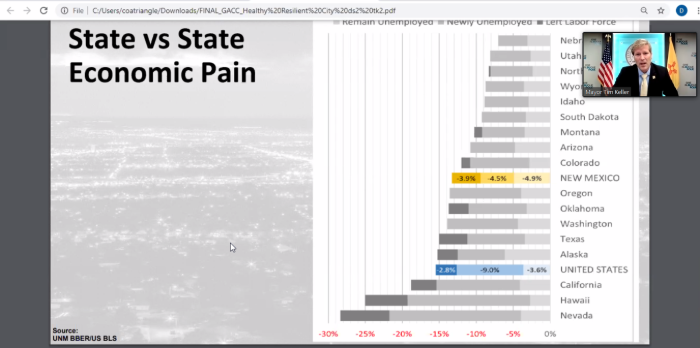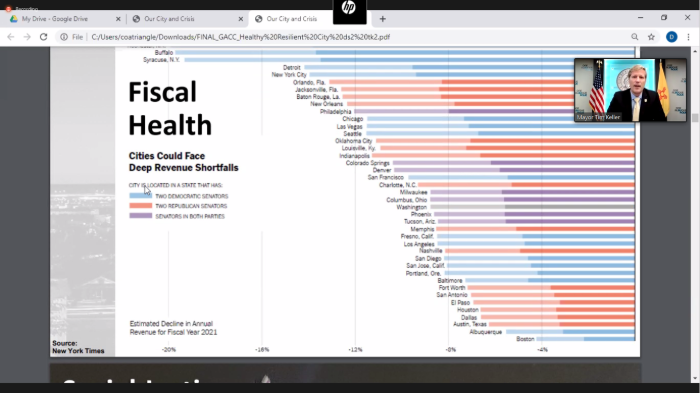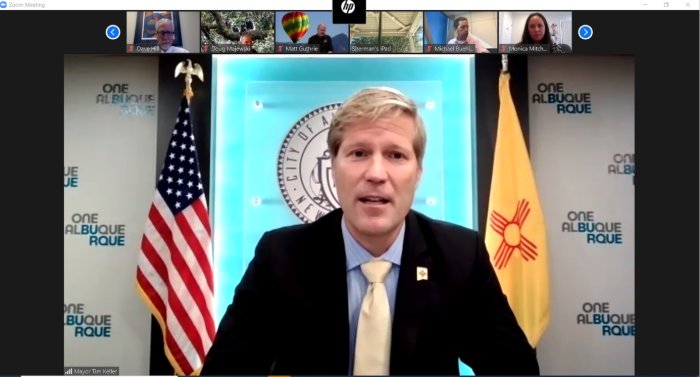“We decided we were going to carve our own path,” said Mayor Tim Keller of the early coronavirus response decision-making process, even before the COVID-19 pandemic made landfall in the United States.
Keller presented to the GACC board on September 24, looking back at the past few months of a city battered by a pandemic and social unrest, assessing Albuquerque’s current situation, and looking ahead with hope.
He described City orders that focused on the economy, health, and safety, and did not necessarily follow other cities’ responses to the virus. He said that the City quickly mobilized to provide childcare to essential workers, support the homeless, and even regulate toilet paper purchases to prevent hoarding.
Among the City’s greatest coronavirus accomplishments is the fact that Albuquerque has maintained better-than-expected economic figures and city revenues due to largely uninterrupted construction projects and the expedited distribution of federal assistance. The New York Times ranked cities across the country with the deepest revenue shortfalls. Albuquerque was among the fiscally healthiest in the nation, second only to Boston – see the graphic below. Even national rankings of unemployment show that, in spite of our community’s woes, our state has not been hit as hard as other states. Another graphic below shows New Mexico falling about halfway down the ranking. “We’re feeling our share of the pain, but we’re certainly not an outlier; we’re right in the middle,” Keller summarized.
Keller also praised local law enforcement for their successful handling of a summer punctuated by protests and demonstrations: “The fact that we’ve had 41 protests and people think we’ve only had two – the downtown one and the Oñate one – is a testament to how great a job our police department has done,” he said.
However, he also acknowledged that there is still work to be done. Mid-year crime rates show marginal decreases in most categories over the last three years, and while residential property crime has increased as commercial property crime decreased due to coronavirus, the “crimes against person” category remains largely flat. Albuquerque is actually experiencing an increase in aggravated assault (6%), though that rise is smaller compared to the spikes in other major cities.
When asked for an update on the federal COPS grant of $9.7 million for hiring additional law enforcement officers, Keller said that his administration had backed the program from the start; he said the President’s conflation of Albuquerque with cities seeing riots, like Portland and Kansas City, led to the delay in accepting the grant funding. He said that the spirit of the program had never presented an issue, and that he and the City Council had signed off on it.
Keller also described the new landscape for people in Albuquerque experiencing homelessness. While spread among the homeless community has been minimal – particularly compared to other major cities – he said the pandemic crisis reinforced the need for a 24/7 gateway center for the homeless, which would serve as a drop-off location for first responders to take the homeless, provide some overnight shelter, and connect homeless individuals to the services they need in a more coordinated manner.
Looking ahead, Keller suggested using New Mexico’s exemplary coronavirus response as a tool for attracting businesses and workers alike, particularly as telework seems to be here to stay for longer than we once thought. If employees can work from anywhere, they might as well work from New Mexico, with its lower medical costs, clean air, and low COVID-19 numbers like cases, deaths, and positivity rates. And indeed, a national ranking of “net movers” show Albuquerque ranked sixth in the country for more people moving to the area than moving away. That graphic can be seen below.
Keller concluded his presentation by saying, overall, he felt hope for Albuquerque in spite of its challenges, and that he believes the coronavirus may present Duke City with a new opportunity to stand out among its competition as a healthy place to live and work.









